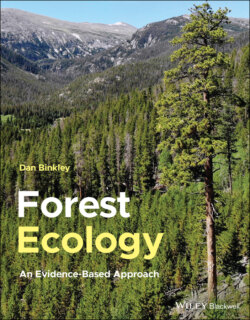Читать книгу Forest Ecology - Dan Binkley - Страница 40
Temperature Variation Over Time, and Across Space, Strongly Influences Forest Ecology
ОглавлениеThe complex physics of radiant energy and heat transfers come together to determine the temperatures that influence the development and success (or failure) of organisms. For example, the differences in incoming sunlight between N‐ and S‐facing aspects of a glacial valley in Colorado, USA resulted in an average difference in air temperature (2 m above the ground) of 1 °C, the equivalent difference associated with a 200‐km difference in latitude (on flat terrain). This difference was also large enough to affect the accumulation and retention of snow, which in turn influenced soil temperatures. Snow is a good insulator, and soils beneath deep snow may stay near 0 °C in winter, compared to lower temperatures in soils unprotected by snow. In December, a small amount of snow on the cooler N‐facing side of the valley kept soil temperatures a few degrees warmer than across the valley on the S‐facing slope (Figure 2.15). In May, the greater accumulation and slower melting of snow on the cooler N‐facing side kept the soil near freezing while the soil on the S‐facing warmed with spring sunshine.
Patterns that result from seasons, latitudes, and aspects are further modified by the structure and dynamics of forests. Fires can reduce the tree canopy, shifting the absorption of solar energy from leaves to soils. Forest harvesting similarly alters how radiation influences temperatures, and even how the convection of air influences temperatures at the soil surface. Harvesting a forest at high elevation in Montana, USA led to much hotter temperatures at the soil surface (Figure 2.16). Perhaps more surprising is the effect on nighttime low temperatures. Without a forest canopy, a thin layer of very cold air may settle near the soil surface, with higher emissivity of the soil (compared to the air) accentuating cooling. The presence of tree crowns promotes more mixing of the air, limiting the ability of cold air to settle on the soil (Löfvenius 1993), and provides for a closer match in emissivity between soil and tree canopies (compared to soil and air). This is one reason that harvesting prescriptions may retain some live trees (green tree retention, or shelterwood designs).
FIGURE 2.15 The temperatures of the soil (10 cm below the O horizon) differed between north‐ and south‐facing aspects in this glacial valley in Colorado, USA (2750 m elevation), in part because of the effect of aspect on snow accumulation, retention, and time of melting.
FIGURE 2.16 Removing some or all of the tree canopy from a high‐elevation forest in Montana, USA (upper) resulted in much higher mid‐day temperatures at the soil surface on a day in August, and the clearcut site actually experienced nighttime lows below freezing. Just as temperatures change through a day (and year), they also differ over space. Patterns of temperatures within a clearcut site vary substantially with the soil surface materials, with very large implications for microsites where new plants might establish.
Source: Based on Hungerford 1980.
Large differences in temperature also occur among locations within a forest, especially after the tree canopy has been reduced or removed. An afternoon in the clearcut site in Montana had an air temperature of 34 °C, but temperatures of dry organic matter at the soil surface exceeded 50 °C (Figure 2.15), hot enough to kill tree seedlings. Bare mineral soil was somewhat cooler, because mineral soil conducts energy deeper into the soil, reducing the peak temperatures at the surface. Decaying logs were the coolest, as water accumulated in the wood evaporated and consumed energy. These spatial patterns of temperatures of course vary through a day and across seasons, and they illustrate some of the detailed interactions that are always important in determining local temperatures.
FIGURE 2.17 Buds on spruce trees in northern Sweden burst open and expand new needles near June 3 each year, but warm springs may see budburst come in mid‐May, and cold springs may have budburst delayed till late June. The timing of budbreak is less variable when examined based on the accumulation of warm days; the average of 130 growing degree days (with a baseline temperature of 5 °C) shows relatively narrow variation across years.
Source: Based on Langvall et al. 2019.
